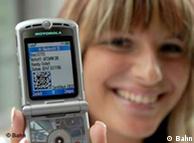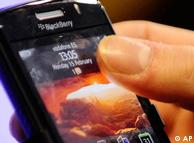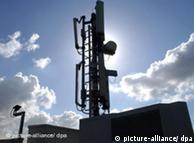Remember all the hype in Europe a few years ago about a
next-generation mobile phone technology promising "near-DSL” data
transmission speeds?
The technology, known by two abbreviations UMTS (Universal Mobile
Telecommunications System) or 3G (third-generation), proved to be nearly
as fast as molasses for surfing the Web. And, to be honest, many users
today hardly notice the improved speeds of an enhanced version of the
same technology with another tongue-twisting name – HSDPA (High-Speed
Download Packet Access).
Coveted spectrum
Now the telecoms industry is telling us to fasten our seatbelts for
another even faster mobile communications technology. And, like nearly
all innovations in this sector, it is known by its abbreviation, LTE
(Long-Term Evolution), or its more generic name 4G (four-generation).
Last week, Germany sold a range of frequencies that can be used for
new 4G services. After 224 rounds of bidding over some six weeks, the
country became the first in Europe to sell the coveted spectrum via an
auction.
Germany's four existing operators purchased various chunks of
spectrum for different prices in last week's auction. Vodafone paid 1.42
billion euros for 12 blocks, Telefonica's O2 1.38 billion euros for 11
blocks, Deutsche Telekom 1.3 billion euros for 10 blocks and Royal KPN's
E-Plus 283.6 million euros for 8 blocks.
Although the auction's total revenue of nearly 4.4 billion euros was a
welcome windfall for German state coffers, it fell far short of the 50
billion euros generated from the sale of 3G frequencies in 2000. It was
also below analyst expectations; the accounting firm KMPG estimated that
the auction would pull in 6-8 billion euros.
 Bildunterschrift: Großansicht des Bildes
mit der Bildunterschrift: Operators
aim to make users happier with faster, more advanced servicesA
key reason for the significantly lower bids was the line-up of
contenders. There were no newcomers in Germany's 4G auction, as there
were in its earlier 3G spectrum sale. Back then, two completely new
players and two existing operators – all eager to grab a slice of the
lucrative mobile phone market– helped push prices sky high. They placed
top bids for spectrum they believed would allow them to "print money” – a
phrase often used to describe the billions of euros Germany's first
mobile phone operators, Deutsche Telekom and Vodafone, made from their
2G (second generation) digital cellular services.
Bildunterschrift: Großansicht des Bildes
mit der Bildunterschrift: Operators
aim to make users happier with faster, more advanced servicesA
key reason for the significantly lower bids was the line-up of
contenders. There were no newcomers in Germany's 4G auction, as there
were in its earlier 3G spectrum sale. Back then, two completely new
players and two existing operators – all eager to grab a slice of the
lucrative mobile phone market– helped push prices sky high. They placed
top bids for spectrum they believed would allow them to "print money” – a
phrase often used to describe the billions of euros Germany's first
mobile phone operators, Deutsche Telekom and Vodafone, made from their
2G (second generation) digital cellular services.
It's worth noting that both newcomers later abandoned the market. And
the billions of dollars invested in spectrum severely drained
operators' budgets to buy, build and operate new 3G networks. Delays
resulted. And, in the midst of this, the Internet bubble burst, putting
even greater pressure on operators to watch their bottom line.
Another reason for the lower prices paid this time around is the
bundle of regulations linked to the coveted 800 megahertz (MH) band, one
of three bands sold in the auction. In an effort to expand broadband
services to less populated areas, the German government has required
operators buying 800 MHz frequencies to build wireless networks in rural
areas before moving to cities. These regulations, according to Stefan
Zehle, chief executive officer of Coleago Consulting in the United
Kingdom, prompted potential newcomers to think twice about entering the
German market.
Return on investment
"Mobile operators usually roll out networks in urban areas where
there is the greatest density of population to maximize their return on
invest,” Zehle said. Understandably, the value of the spectrum is lower,
he added, if they have to invest in areas they regard as "marginal or
even uneconomic.”
Under the regulations, operators must first build networks that cover
90 percent of the population in villages with a population of not more
than 5,000 inhabitants. After they have achieved this coverage, they can
enter the next phase. In phase two, for instance, they must extend
coverage to towns from 5,000 to 20,000 inhabitants and in phase three in
towns from 20,000 to 40,000. Only in phase four can they roll out
service in big cities.
 Bildunterschrift: The future, experts say,
is the mobile InternetSpectrum is the life blood of the
mobile industry, and many operators crave the 800 MHz band. Previously
used for analog TV, the so-called "digital dividend” band has two big
benefits: wider geographic coverage and greater in-building penetration.
Bildunterschrift: The future, experts say,
is the mobile InternetSpectrum is the life blood of the
mobile industry, and many operators crave the 800 MHz band. Previously
used for analog TV, the so-called "digital dividend” band has two big
benefits: wider geographic coverage and greater in-building penetration.
Low frequencies allow radio signals to propagate further. As a
result, fewer base stations are required. And that means less capital
expenditure is required to provide coverage compared to higher
frequencies, such as the 1.8 gigahertz (GHz), 2 GHz and 2.6 GHz, which
were also sold in the German auction.
The lower frequency range also provides better in-building
penetration. Such penetration is becoming increasingly important to
operators as they strive to meet growing demand for mobile phone
coverage deep inside office buildings and larger residential complexes.
Although operators can deploy other technologies to amplify signals in
buildings, especially those with heavy steel and concrete structures,
they incur additional operating costs.
Technology neutral
O2 and Vodafone each spent 1.2 billion euros on the 800 MHz band,
while Deutsche Telekom paid 1.15 billion euros. E-Plus failed to secure
spectrum in this band.
The Dutch-owned company also appears to be the only mobile phone
operator in Germany with no immediate 4G plans. Although licenses for
the new spectrum are "technology neutral,” meaning operators are free to
use them as they please, Deutsche Telekom, Vodafone and O2 have made
their 4G intentions well known.
So why now the push to yet another next-generation mobile
communications technology? Operators in Germany and across Europe no
longer see sustainable growth in a strategy based heavily on traditional
telephony. The future, they say, is data and services like high-speed
Web surfing, social communities, video and even Internet-based voice and
chat services like Skype. To deliver all these more efficiently, they
need a new technology. Many of them believe LTE is the solution.
 Bildunterschrift:
Großansicht des Bildes
mit der Bildunterschrift: 4G
technology is expected to provide better coverage in built-up areasIn
a nutshell, the next-generation mobile network promises to deliver
higher throughput, lower latency and larger bandwidth over a simple,
flat architecture based on the Internet Protocol (IP) – all sorely
missed in the first generations of digital cellular phones: GSM (Global
System for Mobile Communications) and UMTS.
Bildunterschrift:
Großansicht des Bildes
mit der Bildunterschrift: 4G
technology is expected to provide better coverage in built-up areasIn
a nutshell, the next-generation mobile network promises to deliver
higher throughput, lower latency and larger bandwidth over a simple,
flat architecture based on the Internet Protocol (IP) – all sorely
missed in the first generations of digital cellular phones: GSM (Global
System for Mobile Communications) and UMTS.
As for higher speeds, LTE has both a low and high mobility
specification. The high mobility spec aims to provide service to users
travelling at high speed on trains or highways between 60 kilometers per
hour (km/h) to 250 km/h or more and supporting data rates up to about
100 megabit per second (Mbit/s). Low mobility delivers services in
hotspots at data rates of 1 gigabit per second (Gbit/s). These are
theoretical speeds. It remains to be seen what speeds operators actually
offer. But users will experience a noticeable change regardless.
Latency, which is important in computer games and Web surfing, is
another big service differentiator. Latency times with HSDPA are
currently around 65 milliseconds, compared to about 20 milliseconds with
DSL (Digital Subscriber Line) lines. LTE is targeting 10 milliseconds.
High expectations
In another effort to improve efficiency, new 4G networks will use
smart antenna technology, known as Multiple Input-Multiple Output
(MIMO). The technique boosts bandwidth and range by using multiple
antennas at both the transmitter and receiver end to improve
communication performance.
Another LTE innovation is a mouthful to speak – Orthogonal Frequency
Division Multiplexing or OFDM. The technology has been integrated into
LTE because it enables high data bandwidths to be transmitted
efficiently while still providing a high degree of resilience to
reflections and interference.
 Bildunterschrift: Großansicht des Bildes
mit der Bildunterschrift: The
iPhone has generated lots of interest in new mobile Internet
applicationsCritics of UMTS say one of the big reasons
why the technology never fulfilled all its high expectations was that it
lacked a "killer application.” Some experts believe LTE awaits the same
fate unless it offers something special, like video.
Bildunterschrift: Großansicht des Bildes
mit der Bildunterschrift: The
iPhone has generated lots of interest in new mobile Internet
applicationsCritics of UMTS say one of the big reasons
why the technology never fulfilled all its high expectations was that it
lacked a "killer application.” Some experts believe LTE awaits the same
fate unless it offers something special, like video.
Others beg to disagree. "I don't see video as a killer application in
4G,” said German telecoms expert Torsten Gerpott, a professor at the
Mercator School of Management at the University of Duisburg Essen. "4G
doesn't need a killer application.”
Gerpott and many other experts believe there is a general move toward
what the industry now calls the "mobile Internet.” People at home and
work want to use their mobile devices to access many of the same
services, such as e-mail, Web surfing and video, at the same speeds and
with the same latency as they do on their PCs. The iPhone has shown how
an easy-to-use, Internet-enabled device can create demand for such
mobile Internet services. And, most recently in the United States, it
has also shown why operators need plenty of spectrum and a new
technology to provide them.
Four German operators have just purchased the next-generation
spectrum. And at least three of them are now betting on LTE to deliver
the goods.
Author: John Blau
Editor: Sam Edmonds
http://www.dw-world.de/dw/article/0,,5603789,00.html












